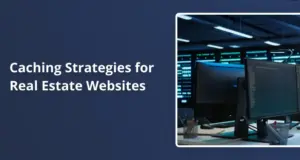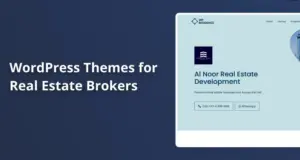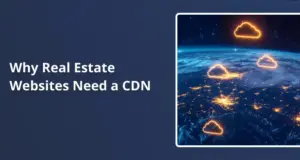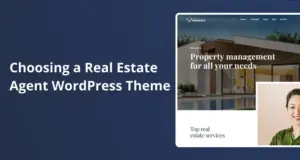A well-made real estate site does more than list prices and room counts. It’s a neighborhood newsletter, a mini data lab, and a friendly local guide all rolled into one. Buyers browse listings before their coffee is brewed, skim local updates during their commute, and delve into price trends late at night.
Sellers notice this behavior and often choose the agent whose site already answers tough local questions. WordPress gives you the flexibility to deliver that value. With the proper setup, you can post market updates in the morning, tweak a school zone map at lunch, and share a sunset photo reel before the evening lights come on.
Local Content Solves Real Problems
Most people don’t start their home search focused on bedrooms and bathrooms. They wonder if their toddler can sleep through the traffic on Maple Street or whether dogs can run off-leash in Pine Creek Park at sunrise. When your site helps them solve those minor, daily concerns, trust builds fast.
Detailed, locally focused paragraphs outperform the big national sites that stop at listing fields. Search engines also appreciate that level of detail. Almost half of all searches include a location, so Google looks for signals like street names, bus stops, and school codes.
A page titled /life-near-pine-creek-greenway/ speaks more directly to what users are searching for than a generic “Pine Creek Guide.” Tag it with details like trailheads, tax ID numbers, and sale dates so that search engines recognize it as a timely and reliable source.
The user journey often follows a familiar path: first, they check fireworks rules; then, they compare townhomes to condos; and finally, they click to call an agent.
If you guide them with a local story, back it up with ZIP-code-level data, and provide a straightforward way to connect, they’ll stay on your site through every step, instead of bouncing back to a generic portal after one scroll.
Neighborhood Spotlights: The Foundation Stone
A great neighborhood feature should feel like a walking tour from someone who’s lived there forever, someone who knows every mural and the shortcut that avoids rush-hour traffic.
Blend statistics like average sale price and days on the market with hyperlocal colors, such as the alley that transforms into a chalk-art gallery each June.
Essential elements
- Hero photo that anchors mood and location.
- Plain-spoken background story in three to five lines.
- Recent MLS statistics are updated monthly.
- At least one hidden gem: “Tuesday farm stand behind the library,” “Sunrise yoga on the pier,” or “Block-party potluck every August.”
Create a custom post type for neighborhoods using CPT UI, and add ACF (Advanced Custom Fields) for features such as walkability, public transit, noise levels, and even compost pickup day.
Build a block template featuring a hero image, a two-column story and map, a Visualizer price chart, a photo gallery, and an author box. Next time you feature a district, simply update the data and images.
Photos are key, so spend a Saturday morning snapping shots of storefronts, trailheads, and golden-hour streets. Compress them with ShortPixel and serve WebP format to keep things fast. Focus on captions over filters: “Local teens repaint this fence every spring.” Small, human moments boost engagement.
School-Zone Updates: Accuracy Builds Trust
Parents pay close attention to school zones, boundaries shift, magnet programs launch, and test scores change each year. Always start with an official map from the district and note the date it was downloaded. If the zones change, upload the new file and add a line like: “Updated April 2025 after changes to elementary catchments.”
Use WP-Crontrol to schedule twice-yearly reminders to check and refresh school pages. Store the original boundary files (CSV, PDF, etc.) in your media library and link to them so families can easily verify the information.
Skip rating schools yourself, instead, link to the state’s school report cards. Facts over opinions help avoid legal trouble and build trust. Add thoughtful extras, such as when the earliest bus picks up or a note about a grant-funded STEM lab, to keep the content warm and helpful.
ZIP-Code Market Trends: Numbers With Meaning
City-wide averages often miss the real story. A hospital or research park opening just a few miles away can lift one ZIP code while another stays flat. Export sales data monthly, upload via WP All Import, map it to ACF fields, and use Visualizer to draw new trend lines.
Don’t let the chart speak alone, explain what’s behind the data. Maybe condo prices spiked due to a light-rail extension. Maybe inventory dropped after a local company hired 200 new employees. Add meaningful alt text like: “Chart showing a steady rise in ZIP 61523 from January 2024 to May 2025.”
Instead of a dry bullet list, follow the chart with a friendly Q&A. Discuss whether now is a good time to list, how long buyers can expect to search, and whether these trends are likely to persist and keep the tone calm, not hyped.
Tips for Creating Local Pages in WordPress

The block editor makes it easy to build modular, reusable layouts. Start with a hero image, drop in a two-column block, add your chart, and lock key sections to prevent guest writers from accidentally shifting design elements.
Layout tips
- Group blocks by type story, stats, photos, so it’s easy to adjust styles later.
- Assign CSS classes (such as .section-story) for quick site-wide color or layout changes.
- Lock the author and hero sections to avoid accidental edits.
Choose a lightweight theme, such as WpResidence, Astra Pro, Kadence, or GeneratePress. Keep JavaScript to a minimum, PageSpeed punishes bloat. Each post should include an author card with the following information: license number, local board ID, and a photo.
Display a “last updated” badge that pulls directly from the post’s modified date so readers and Google know it’s fresh.
SEO Basics That Stick
Yoast SEO and RankMath both add local schema once you fill in the business name, address, and phone. After that, breadcrumbs appear in search snippets without extra work. Keep one H1 per page, slugs under seventy-five characters, and headings that guide skimmers.
On-page quality relies on four habits: write alt text that describes rather than labels, weave internal links between related guides, cite city-planning minutes or assessor tables for authority, and craft meta descriptions that read like invitations, “Walk scores, hidden trails, updated prices, Oakwood Heights 2025.”
Those cues together convince crawlers to spend their budget on your priority pages.
Visual Media: Photos, Clips, and Maps
Strong visuals increase time on the page. Keep images under 150 KB, strip out unnecessary metadata, and use the WebP format. Tools like ShortPixel handles all three.
Film a short vertical video like a 60-second sunset sidewalk tour and add captions in CapCut. WordPress lazy loading keeps performance smooth. Include a transcript so silent scrollers still get the story.
OpenStreetMap embeds don’t need an API key. Pin labels (cafés, parks, bike docks) can be pulled from ACF fields, keeping your map, photo gallery, and schema in sync. On mobile, these maps load quickly and feel native to the page.
Community Event Pages: Beyond Listings
Covering local events helps build trust and improve SEO. There’s usually low competition for search terms like “food truck Friday in ZIP 90210.” The Events Calendar plugin enables you to create a clean archive of events filtered by ZIP code or topic and display upcoming listings in sidebars across your site.
Send a Friday “Weekend Picks” email through MailPoet to drive traffic and auto-archive fresh content.
Even small teams can handle local event coverage by focusing on yard sales, food trucks, or zoning hearings that affect neighborhoods. After events, post a photo gallery residents love sharing and tagging themselves, which increases your reach without ad spend.
Accessibility and Inclusive Language
Accessibility matters, so keep your heading levels logical, write meaningful alt text, such as “Sunset over Oakwood Heights trail” instead of “trail photo,” and use the WAVE tool to ensure your color contrast scores 4.5:1 or better.
Inclusive language makes everyone feel welcome. Use thoughtful, neutral terms like “main bedroom” or “home needing repairs” instead of outdated phrases. Small changes can make a big difference in how your content is received.
Security and Backend Hygiene
Trust starts with what users can’t see your backend setup. Enable automatic updates for WordPress core, your theme, and trusted plugins. Use a tool like Wordfence to block brute-force attacks, and set daily off-site backups with UpdraftPlus so you can recover quickly.
Enable two-factor authentication for admin users and create a custom login slug using WPS Hide Login to prevent bots from guessing.
Speed, Caching, and Hosting Upgrades
Large media files, such as drone clips and charts, can slow down your site. Hosting providers like SiteGround, Kinsta, and Flywheel are built for WordPress and include optimized caching. Pair your hosting with WP Rocket or LiteSpeed Cache for optimal performance.
Aim for a Largest Contentful Paint (LCP) time of under 2 seconds on a mobile device with 4 G connectivity. Keep layout shifts minimal, defer scripts below the fold, inline CSS above the fold, and limit fonts to two families. Every saved millisecond adds up.
Content Workflows That Last
Even the best post fades without maintenance. Build a repeatable workflow using Notion or Trello.
Cycle Overview
- Idea intake from city agendas, local forums, and MLS alerts.
- Draft in Google Docs using sections that mirror your block pattern.
- Fact check against public records and MLS exports.
- Edit pass trims passive voice, shortens sentences, and inserts brief bullet lists.
- Publication scheduled for early-morning coffee readers.
- Refresh flagged six months later for data sweeps.
This system works for freelancers as well, helping you maintain tone and quality over time.
Trust Signals and Legal Safety
Reference authoritative sources for example, consult your county assessor’s office for property-tax data, police blotters or official crime statistics for public safety information, and FEMA maps for flood-zone status to replace assumptions with verified facts.
Include a brief disclaimer such as “Information confirmed as of May 2025; prospective buyers should reconfirm before purchase.”
When incorporating user reviews, embed them directly from platforms like Google or Zillow rather than paraphrasing, thereby minimizing potential legal exposure. Finally, implement SSL by default; modern browsers increasingly block or warn users about unsecured sites before displaying any content.
Lead Capture Without Breaking UX
Strike the right balance between lead capture and user experience:
- Slide-in prompt: Trigger a discreet slide-in when a visitor reaches approximately 40% of the page. Offer an invaluable asset, e.g., a downloadable dog-friendly trail map or a seller-readiness checklist, to encourage voluntary engagement.
- Exit-intent pop-ups: Reserve pop-ups for high-depth pages, such as market trend analyses, where readers are already invested and may welcome deeper guidance.
Always require double opt-in for email subscriptions. It safeguards user privacy, ensures regulatory compliance, and maintains a clean list.
Social Amplification and Repurposing
A single comprehensive guide can underpin an entire multichannel strategy. On Instagram, highlight a resonant quotation alongside a compelling image to create an engaging carousel.
Share a concise excerpt on LinkedIn to stimulate professional discussion, and recut the feature video into a 15-second Reel or TikTok to capture mobile viewers. Each piece links back to the cornerstone article, reinforcing your topical authority and signaling credibility to every platform’s algorithm.
Measuring Success
Traffic alone misleads, so better focus on depth:
- Scroll depth tracked via Google Tag Manager.
- Session length on spotlight pages using Google Analytics.
- CRM-tagged leads by post category.
Monitor the surge in email inquiries that follow the publication of a zoning-change explainer; the uptick confirms the topic’s relevance.
Watch the inevitable surge in email inquiries that follows the publication of a zoning-change explainer, that uptick is a clear sign the subject resonated and moved readers to act.
When a WordPress site is continually enriched with neighborhood narratives, current data points, and properly cited sources, it evolves into a trusted community bulletin board: prospective buyers consult festival calendars before planning a visit, potential sellers study price trends to time their listings, and long-time residents trade school-zone maps in group chats.
Because the content remains fresh, search engines reward the site with higher rankings, allowing the inbox to fill without relying on a large advertising budget.









